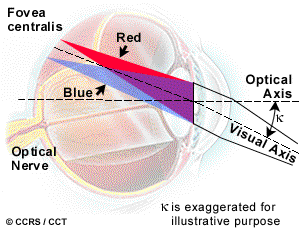Dave's 16 Inch Binocular Telescope Page
A definite three-dimensional feeling is present, the objects appear to float almost in front of you, even though this is obviously not possible due to the enormous distance of these objects. One explanation is an effect called chromatic stereopsis, which due to chromatic aberrations in your eyes makes the red and blue stars focus at slightly different distances. Simple things, like double stars that have never captured my imagination are suddenly transformed into objects worth gazing at. Astronomy for me now has another layer. True stereopsis occurs when your eyes view the same object from a slightly different angle (parallax). The closer the object, the larger the parallax and the larger the 3D effect. When viewing near objects, binoculars can give a true stereoscopic view. However, astronomical objects are simply too far away to produce enough parallax to produce true stereopsis. Also, if the two eyepieces share the optical axis of one telescope, there is no parallax and true stereopsis is not possible even at a close viewing distance. However, as mentioned in another post, horizontal misalignment of the optical axes of two telescopes/eyepieces that are paired as binoculars can produce the appearance of 3D. This occurs because the misalignment forces the eyes to converge or diverge in order to avoid seeing double. With or without a telescope, when your eyes converge to fuse an object the object appears smaller and closer; when your eyes diverge the object appears farther and larger. This does not require parallax between parts of the image itself (such as a star field).
 Your observation that
red stars appear closer than non-red stars when you set the spacing of the
eyepieces to be different than the spacing between your eyes is a well known
effect called chromatic stereopsis (although I haven't heard it mentioned with
respect to stargazing!). It occurs because the fovea of the eye is about 5
degrees temporal to the eye's optical axis and because the pupil of the eye is
slightly decentered nasally. This produces lateral chromatic aberration which
causes differences in retinal location for different colored objects (stars in
this case). The brain misinterprets this as parallax and presents it
perceptually as 3D. Unlike the convergence/divergence effect this effect will
occur even when the telescopes/eyepieces are aligned with optical axes parallel.
Red objects should appear closer to you when the eyepieces are pulled farther
apart, but bluer objects should appear closer to you when the eyepieces are
pushed closer together. From: Roger West <[email protected]>
Chromostereoscopy, or colour stereoscopy, is a three dimensional viewing system
that does not rely entirely on binocular parallax and convergence. This method
is based on the visual phenomenon of
chromostereopsis. When chromostereopsis is positive, blue objects appear
to be at a greater depth than red objects. Einthoven (1885) was the first
scientist to study the chromostereopic effect. He attributed this effect to
transverse chromatic dispersion and the asymmetrical relation of the
visual and optical axes. The visual and
the optical axes of the eyes are not the same. Rays of light imaged on the fovea
strike the corneal surface at an angle. As a result, the cornea and the two lens
surfaces act as prisms. Shorter wavelengths (blue) are refracted more than
longer wavelengths (red). On the retina, blue light is focused towards the nose
while red light is focused towards the temples. Therefore, the red object will
appear to be closer than the blue object.
Your observation that
red stars appear closer than non-red stars when you set the spacing of the
eyepieces to be different than the spacing between your eyes is a well known
effect called chromatic stereopsis (although I haven't heard it mentioned with
respect to stargazing!). It occurs because the fovea of the eye is about 5
degrees temporal to the eye's optical axis and because the pupil of the eye is
slightly decentered nasally. This produces lateral chromatic aberration which
causes differences in retinal location for different colored objects (stars in
this case). The brain misinterprets this as parallax and presents it
perceptually as 3D. Unlike the convergence/divergence effect this effect will
occur even when the telescopes/eyepieces are aligned with optical axes parallel.
Red objects should appear closer to you when the eyepieces are pulled farther
apart, but bluer objects should appear closer to you when the eyepieces are
pushed closer together. From: Roger West <[email protected]>
Chromostereoscopy, or colour stereoscopy, is a three dimensional viewing system
that does not rely entirely on binocular parallax and convergence. This method
is based on the visual phenomenon of
chromostereopsis. When chromostereopsis is positive, blue objects appear
to be at a greater depth than red objects. Einthoven (1885) was the first
scientist to study the chromostereopic effect. He attributed this effect to
transverse chromatic dispersion and the asymmetrical relation of the
visual and optical axes. The visual and
the optical axes of the eyes are not the same. Rays of light imaged on the fovea
strike the corneal surface at an angle. As a result, the cornea and the two lens
surfaces act as prisms. Shorter wavelengths (blue) are refracted more than
longer wavelengths (red). On the retina, blue light is focused towards the nose
while red light is focused towards the temples. Therefore, the red object will
appear to be closer than the blue object.